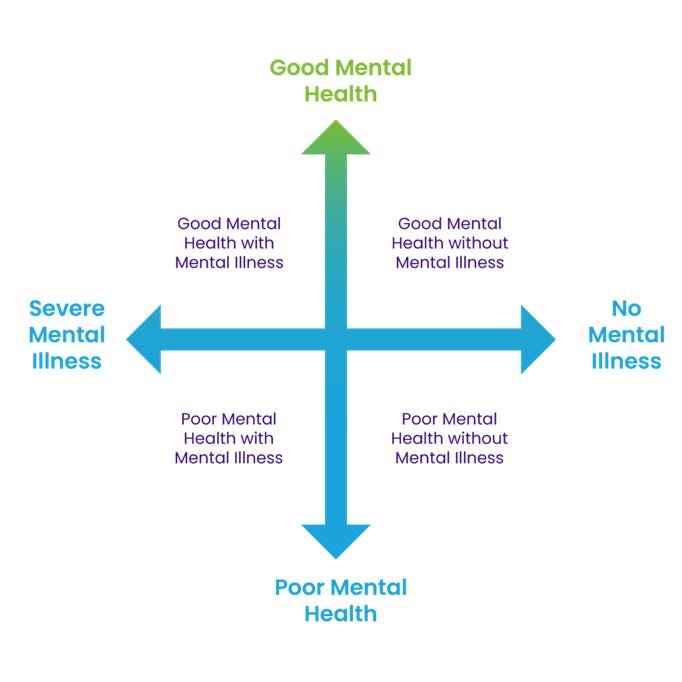YWC Program support pillars
YWC Program support pillars
The foundation of the YWC Program incorporates youth engagement theories and several well-established models of mental health and illness. We describe the program’s key support pillars below.
Mental health continuum
To best understand the relationship between mental health and mental illness, experts look to the “mental health continuum” model. It describes mental health and illness as more than the presence or absence of emotional states; nor are they at opposite ends of a continuum. In fact every person lies somewhere along the mental health continuum and this can fluctuate on a day-to-day basis.
That means individuals can experience complete mental health even if they have been diagnosed with a mental illness. Similarly, individuals who are free of a diagnosed mental illness can still experience poor mental health if they have poor coping mechanisms.
Bottom line: mental well-being is seen as “a balance of the mental, physical, spiritual, and emotional” that gives everyone—even the most vulnerable or mentally ill—an opportunity to live as a whole and healthy individual. The model explains that this balance is enhanced when people feel like their lives have a purpose, they have hope for their future, they feel a sense of belonging and connectedness, and they have a meaning and understanding of how their lives are part of creation and a rich history.

School Mental Health Ontario, The Dual Continuum of Mental Health, Understanding mental health - Students - School Mental Health Ontario
Youth engagement models
Youth engagement is the meaningful and sustained involvement of youth in an activity focused outside the self. It means empowering young persons as partners in their care (CYMHA Quality Standards for Youth Engagement). Youth Engagement models are central to the YWC Program, where youth and adults work together in improving youth mental health.
Youth engagement, as a framework for use in various practice settings, strives to involve youth as valued partners in addressing issues and making decisions that affect them or that they believe are important. Models generally recognize young people’s right to participate in decisions that impact them and acknowledge the great skills and strengths they bring to the table. Youth engagement occurs on a continuum, from youth as passive recipients of services to youth being engaged and seen as equal partners in their care.
Youth engaged in an authentic and meaningful way, leads to the development of the protective factors that promote positive youth development and prevent youth from engaging in risk-taking behaviours. Current research indicates that youth engagement (YE) Models offer a variety of positive outcomes for youth, including lower rates of substance use, lower levels of depression, a significant reduction in dropout rates in school, higher academic performance and lower rates of conflict with the law, particularly for youth who have been categorized as “high risk”.

Manipulation
Young people are directed by adults, without genuine opportunities to provide input.
Decoration
Young people are invited to the table, but given little to no purpose, influence or decision making power.
Tokenism
Young people are included for the sake of saying youth are included—especially those with diverse identities.
Informed
Young people are kept aware of programs, services or policy changes without contributing to the process.
Consulted
Young people have roles, provide input and are told how their input impacts adult decision making.
Co-development & partnership
Young people jointly develop all projects, services and processes that impact or interest them. They have the
opportunity to lead activities, share in decision making and work as equalpartners with adults. Young people and adults have authentic relationships (genuine, trusting, collaborative) in which youth expertise and experience are respected and valued.
Knowledge Institute on Child and Youth Mental Health and Addictions. (N.D.) Youth engagement traffic light [Infographic].
For more information see Enhancing Healthy Adolescent Development, an RNAO Best Practice Guideline® that identifies multiple strategies that directs nursing practice in enhancing healthy adolescent development.
Hart's ladder
The shift in working with youth as clients to engaging them as decision makers can at times seem overwhelming. In order to succeed, youth, adults and the organization as a whole must be open and willing to take risks, think outside the box and develop new attitudes towards youth—not as problems that need fixing, but rather resources to be tapped into.
Roger Hart’s “Ladder of Youth Participation” highlights eight different levels of youth participation and decision-making power. It is a useful tool that challenges us to reflect on the level of participation that is wanted, needed, and possible, as well as to identify barriers to meaningful participation and how they can be overcome. In Hart’s model, the top rung is achieved when adults and youth share decision making as partners and work together (in synergy).
The YWC Program encourages the creation of opportunities with high levels of participation and decision-making power so youth can make change, direct their own activities, and assume shared responsibility with appropriate levels of support. When working with young people, it is important to involve them as partners as early as possible in the decision-making process for an issue, activity or initiative.
Leading Change Toolkit
Leading Change Toolkit provides two complementary implementation frameworks to make change happen.
Resources and tools
YWC program specific resources and tools to support Making Change Happen.

